Abstract
The influence of the vascular endothelium on agonist-induced contractions and relaxations has been measured using intact segments of rat aorta. Contiguous rubbed segments were used as controls. Angiotensin II, histamine, noradrenaline, U46619 and UK14304 contracted both rubbed and intact tissues. The threshold spasmogenic concentrations of these agonists were lower in rubbed tissues than in intact preparations. The sensitivity and responsiveness of tissues to angiotensin II, histamine, noradrenaline and UK14304 were greater in rubbed than in intact tissues. Acetylcholine and histamine relaxed the established spasms of intact tissues but not those of rubbed preparations, These relaxant effects of acetylcholine were abolished by pre-incubation with haemoglobin. In the presence of prazosin, noradrenaline or UK14304 relaxed established contractions in intact tissues. These effects were antagonized by idazoxan or by pre-incubation with haemoglobin. In intact preparations, idazoxan had no effect on the spasmogenic sensitivity and responsiveness to UK14304. Pre-incubation with haemoglobin augmented the spasmogenic actions of noradrenaline, U46619 or UK14304 in intact tissues, but had no effect on these responses in rubbed preparations. Tissue concentrations of cyclic GMP were greater in intact than in rubbed tissues. A concentration of acetylcholine (10 microM) evoking just maximal mechanical inhibition produced a significant increase in cyclic GMP concentration in intact preparations. However, no detectable changes in cyclic GMP concentration were produced by UK14304 (10 microM) or by acetylcholine (30 nM), concentrations which were equi-effective in inhibiting mechanical activity. In the presence of threshold spasmogenic concentrations of noradrenaline, the contractile effects of angiotensin II were augmented and became comparable to those observed in rubbed preparations. In the presence of greater concentrations of noradrenaline, angiotensin II always produced an additional contraction. It is concluded that the presence of the vascular endothelium limits the spasmogenic action of a variety of agonists. Although spasmogens like noradrenaline and UK14304 can stimulate the release of endothelium-derived relaxing factor (EDRF) via alpha 2-adrenoceptors, the inhibitory effects of EDRF largely result from the spontaneous release of this substance.
Full text
PDF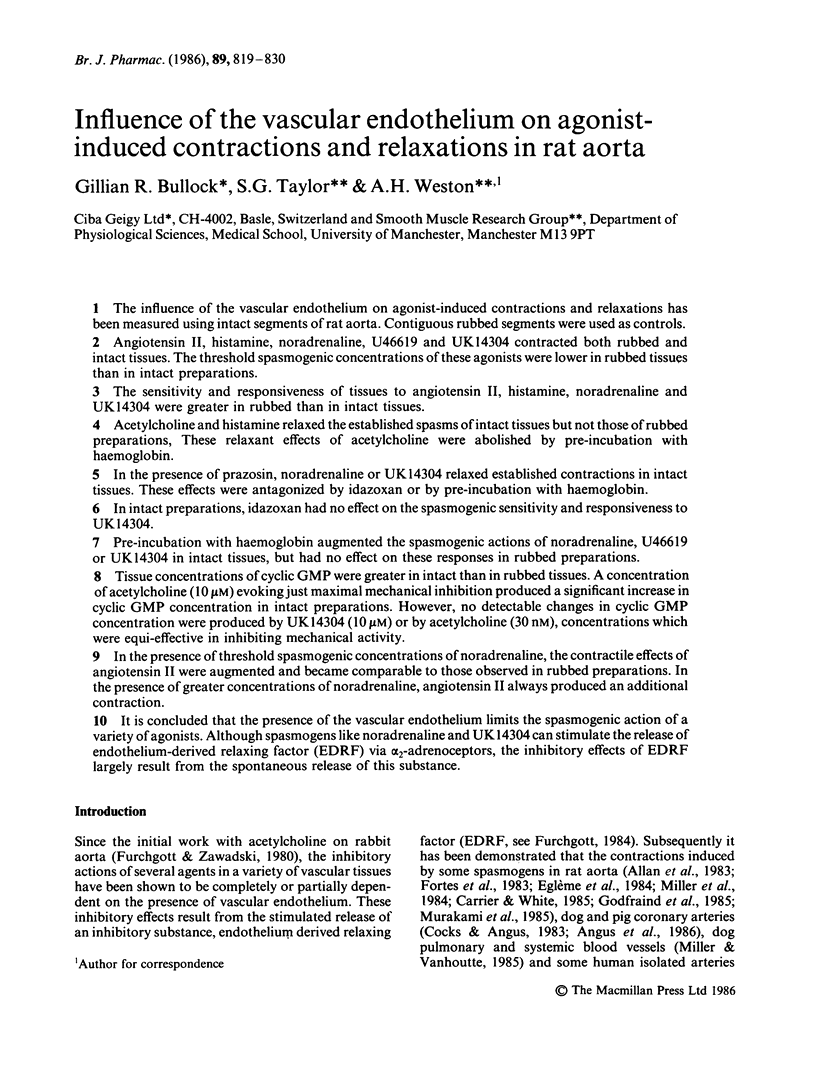

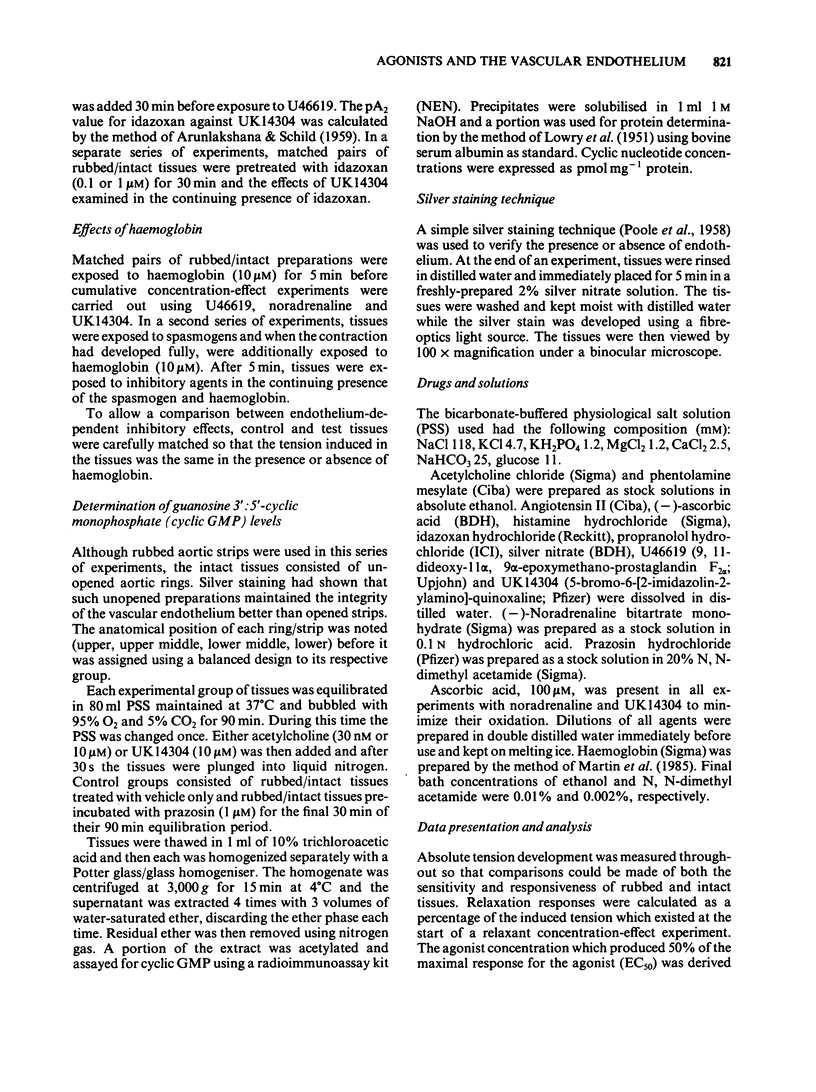
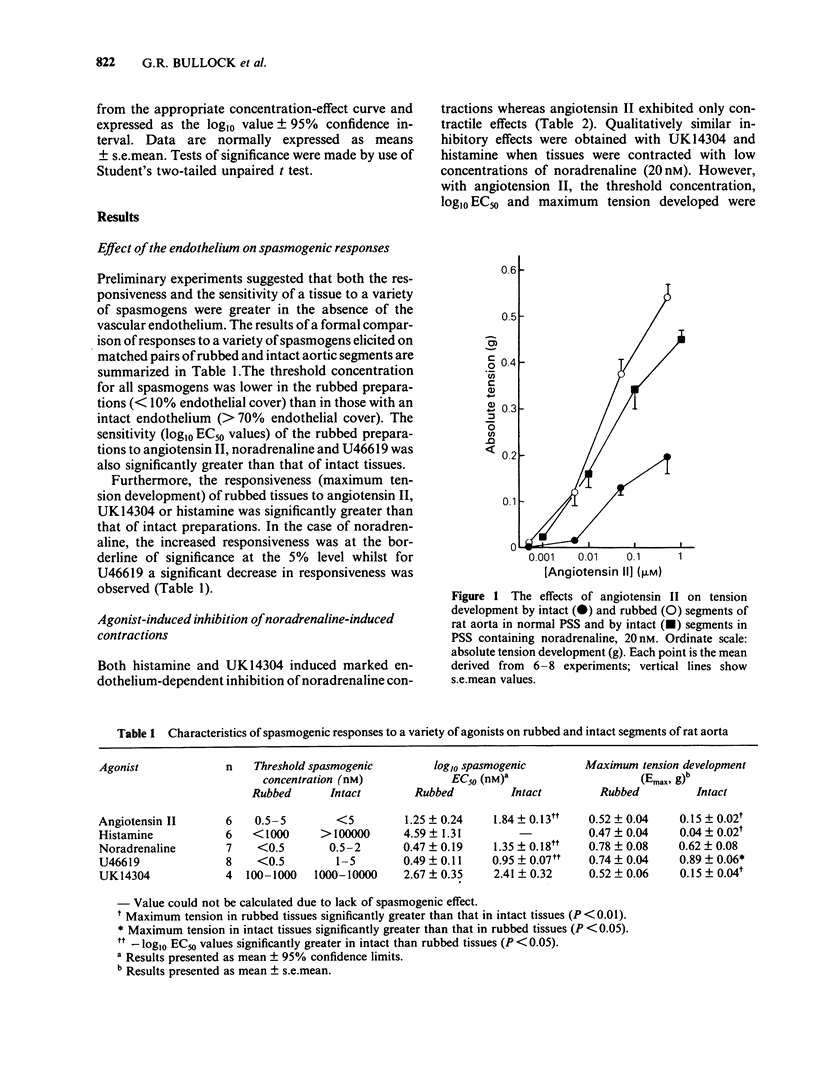
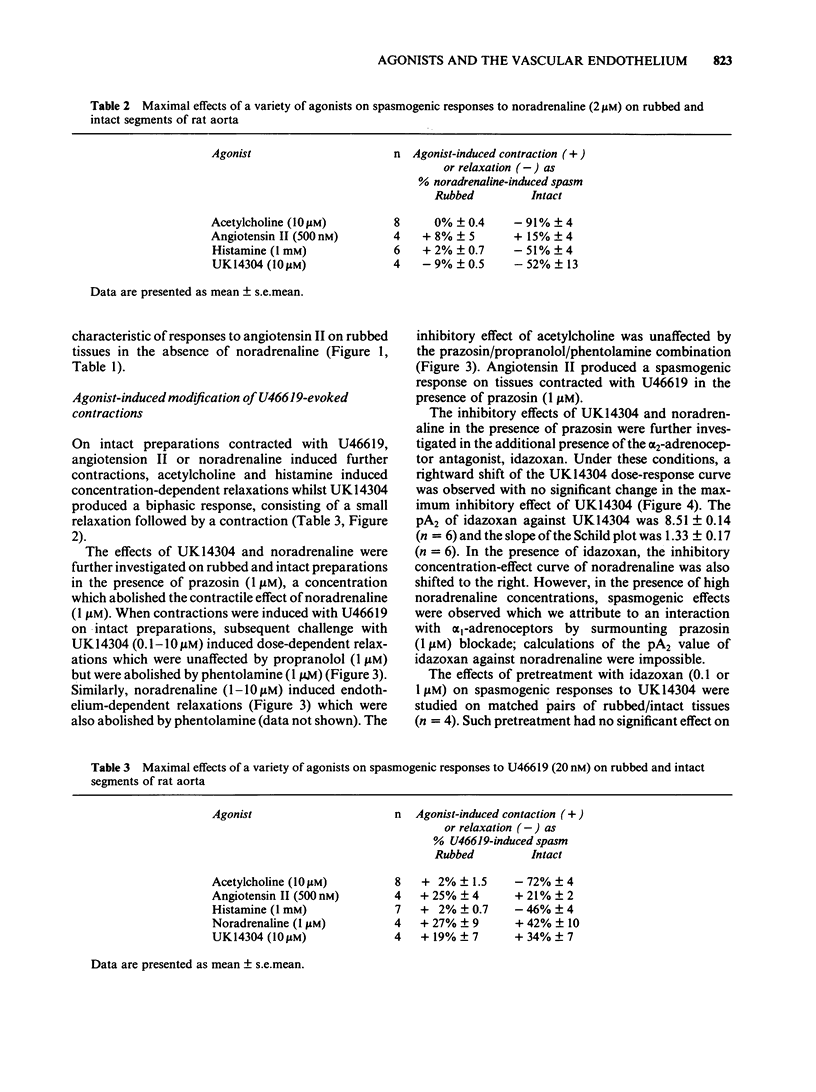
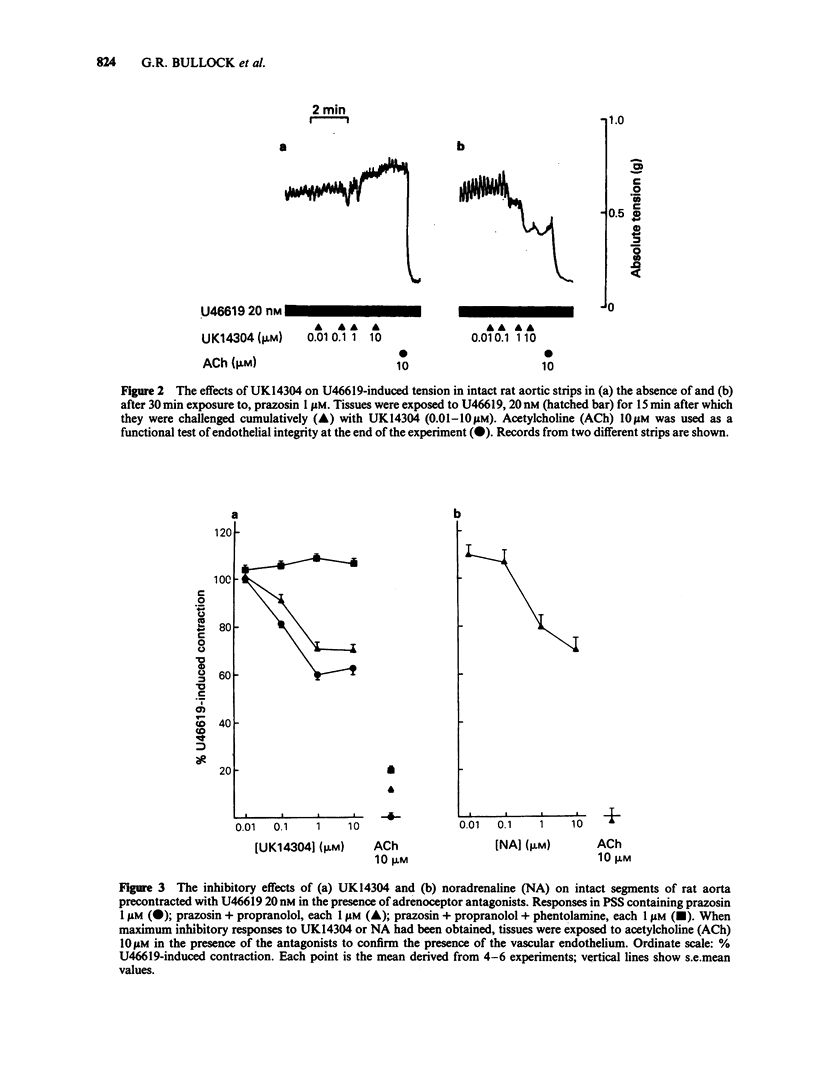
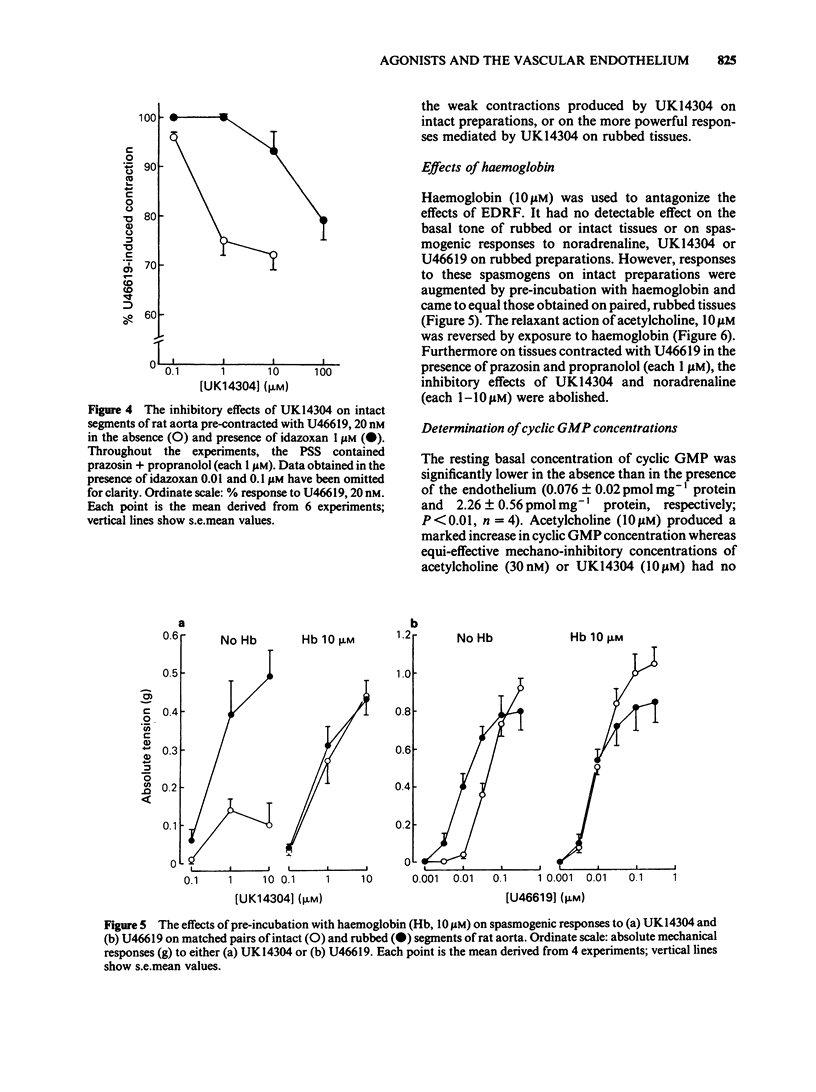
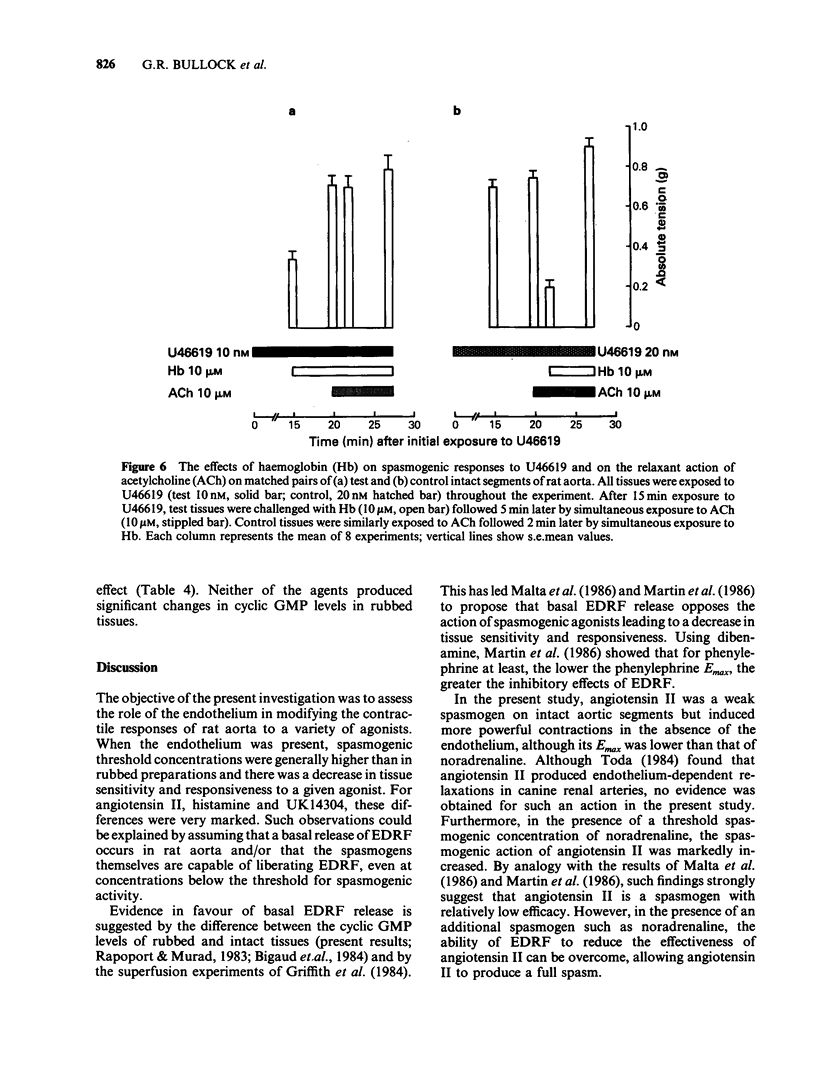
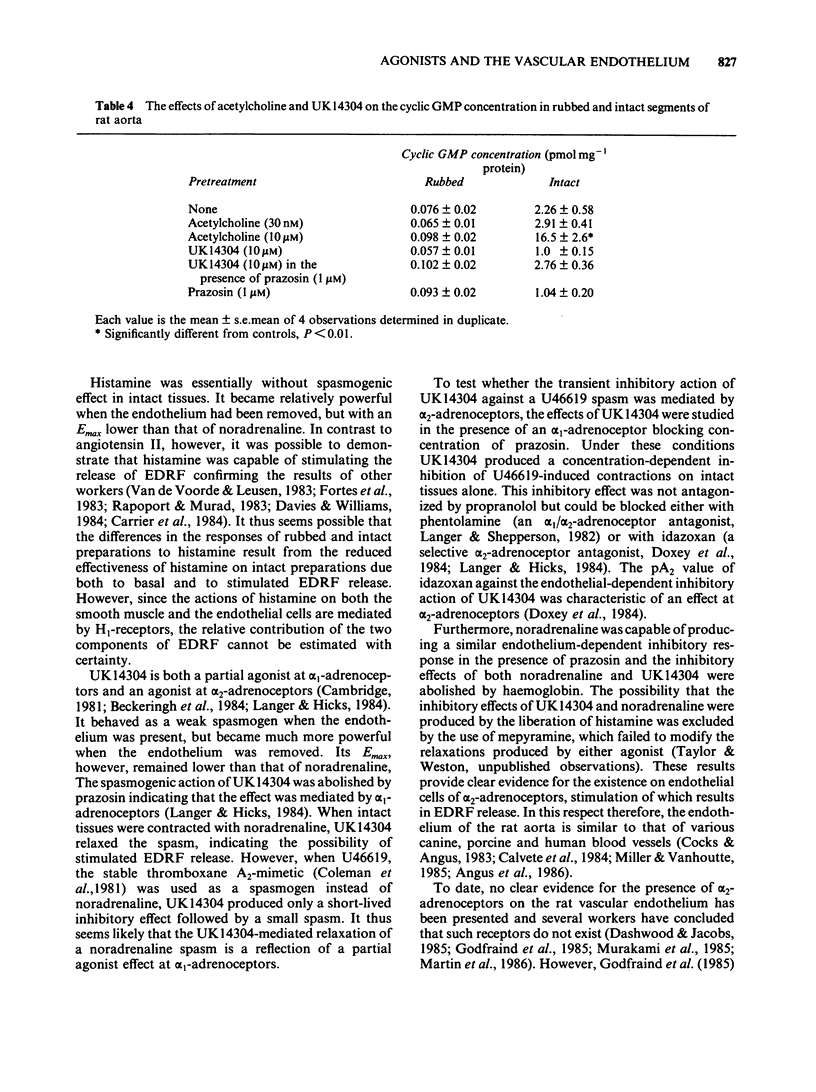
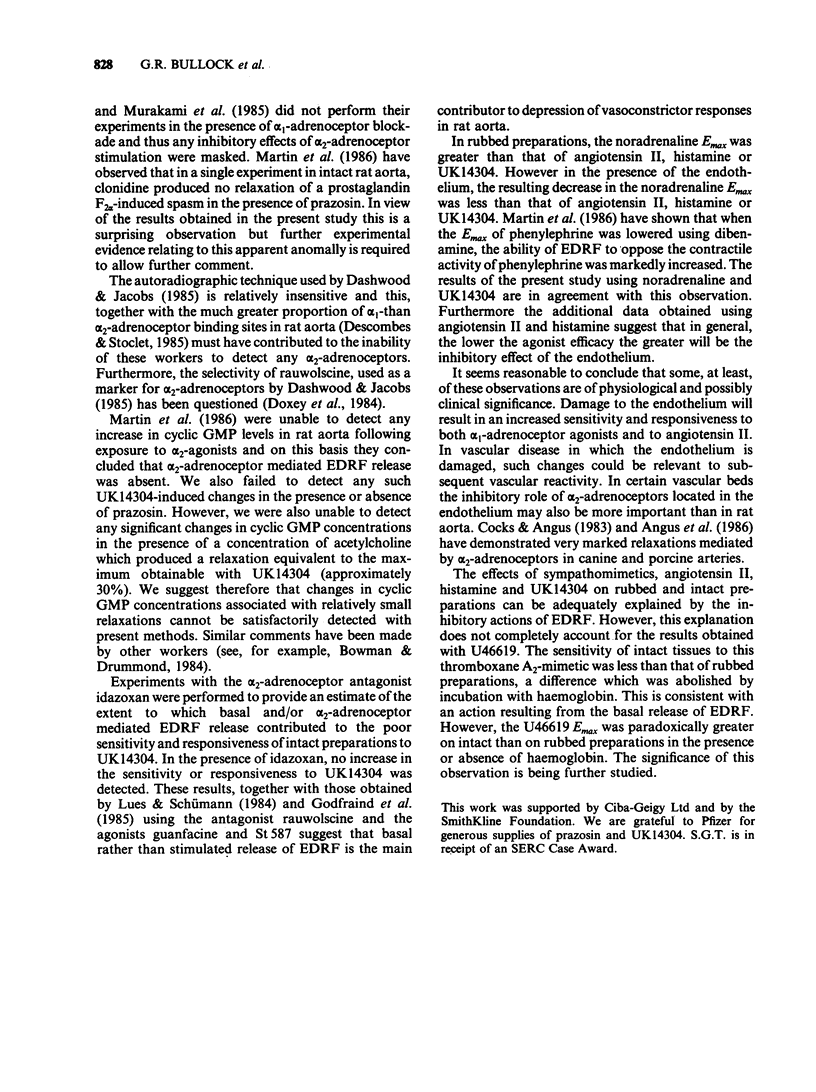
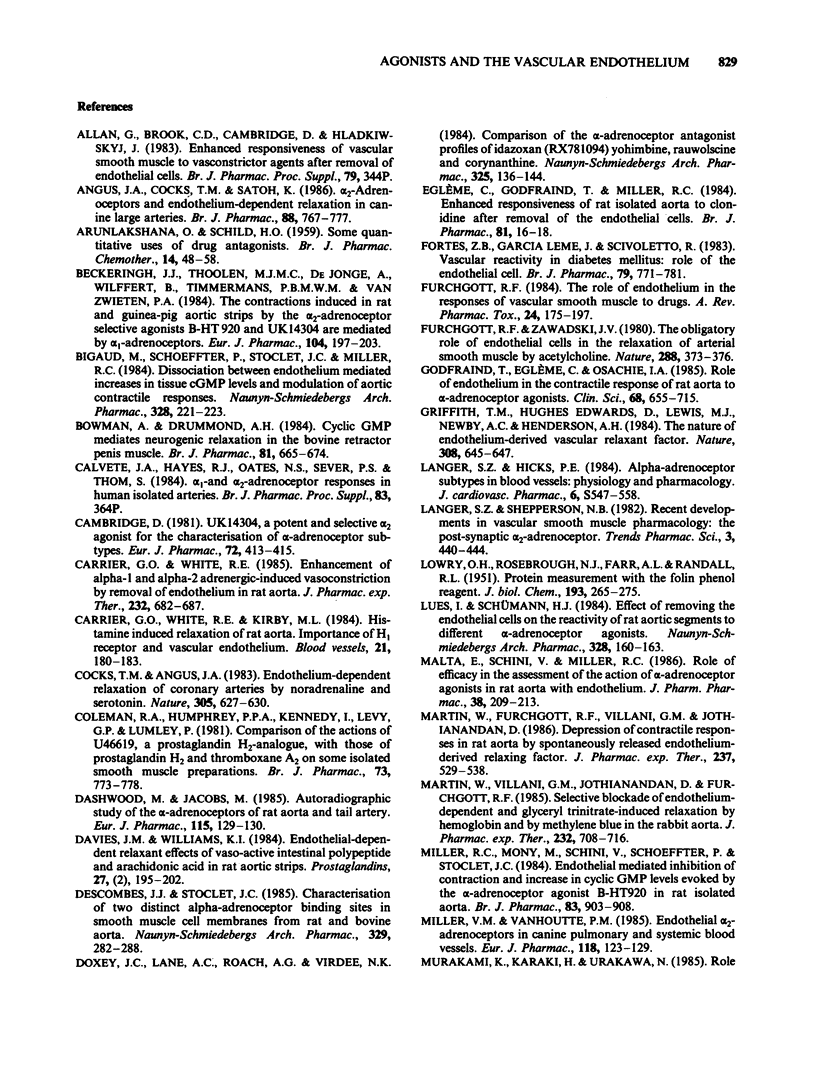
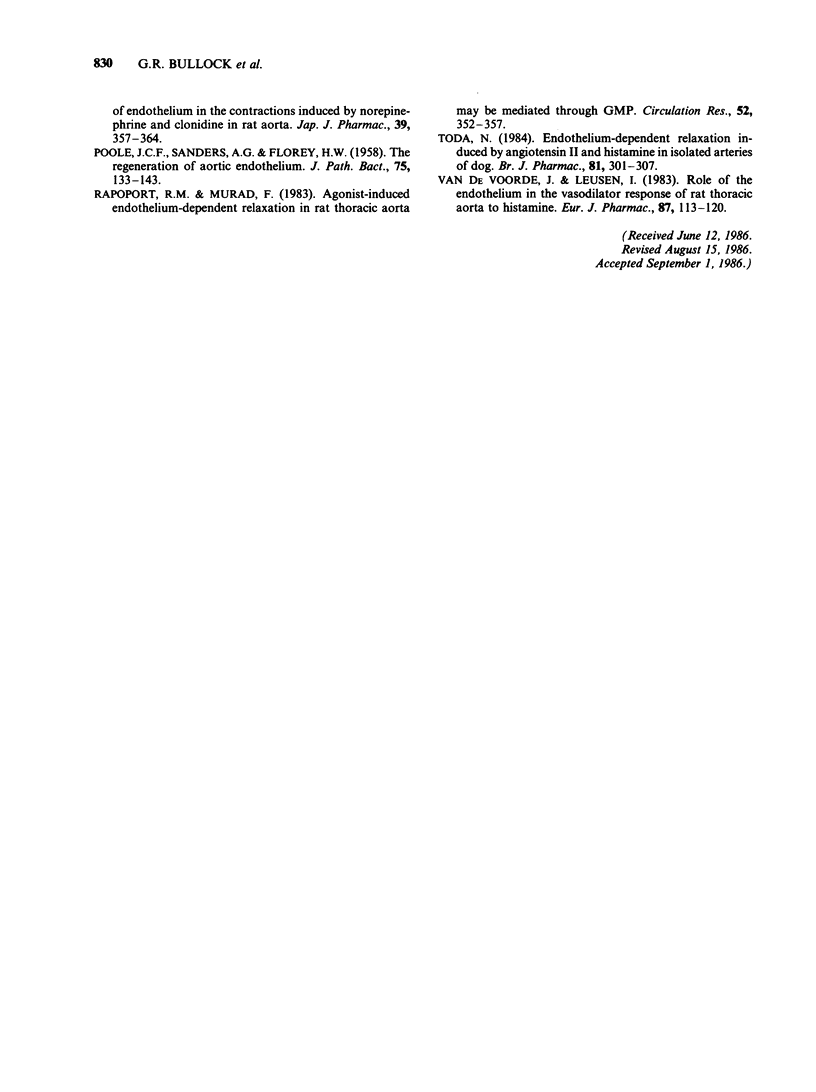
Selected References
These references are in PubMed. This may not be the complete list of references from this article.
- ARUNLAKSHANA O., SCHILD H. O. Some quantitative uses of drug antagonists. Br J Pharmacol Chemother. 1959 Mar;14(1):48–58. doi: 10.1111/j.1476-5381.1959.tb00928.x. [DOI] [PMC free article] [PubMed] [Google Scholar]
- Angus J. A., Cocks T. M., Satoh K. Alpha 2-adrenoceptors and endothelium-dependent relaxation in canine large arteries. Br J Pharmacol. 1986 Aug;88(4):767–777. doi: 10.1111/j.1476-5381.1986.tb16249.x. [DOI] [PMC free article] [PubMed] [Google Scholar]
- Beckeringh J. J., Thoolen M. J., De Jonge A., Wilffert B., Timmermans P. B., Van Zwieten P. A. The contractions induced in rat and guinea-pig aortic strips by the alpha 2-adrenoceptor selective agonists B-HT 920 and UK 14,304 are mediated by alpha 1-adrenoceptors. Eur J Pharmacol. 1984 Sep 17;104(3-4):197–203. doi: 10.1016/0014-2999(84)90394-7. [DOI] [PubMed] [Google Scholar]
- Bigaud M., Schoeffter P., Stoclet J. C., Miller R. C. Dissociation between endothelium-mediated increases in tissue cGMP levels and modulation of aortic contractile responses. Naunyn Schmiedebergs Arch Pharmacol. 1984 Dec;328(2):221–223. doi: 10.1007/BF00512078. [DOI] [PubMed] [Google Scholar]
- Bowman A., Drummond A. H. Cyclic GMP mediates neurogenic relaxation in the bovine retractor penis muscle. Br J Pharmacol. 1984 Apr;81(4):665–674. doi: 10.1111/j.1476-5381.1984.tb16133.x. [DOI] [PMC free article] [PubMed] [Google Scholar]
- Cambridge D. UK-14,304, a potent and selective alpha2-agonist for the characterisation of alpha-adrenoceptor subtypes. Eur J Pharmacol. 1981 Jul 10;72(4):413–415. doi: 10.1016/0014-2999(81)90588-4. [DOI] [PubMed] [Google Scholar]
- Carrier G. O., White R. E. Enhancement of alpha-1 and alpha-2 adrenergic agonist-induced vasoconstriction by removal of endothelium in rat aorta. J Pharmacol Exp Ther. 1985 Mar;232(3):682–687. [PubMed] [Google Scholar]
- Carrier G. O., White R. E., Kirby M. L. Histamine-induced relaxation of rat aorta. Importance of H1 receptor and vascular endothelium. Blood Vessels. 1984;21(4):180–183. [PubMed] [Google Scholar]
- Cocks T. M., Angus J. A. Endothelium-dependent relaxation of coronary arteries by noradrenaline and serotonin. Nature. 1983 Oct 13;305(5935):627–630. doi: 10.1038/305627a0. [DOI] [PubMed] [Google Scholar]
- Coleman R. A., Humphrey P. P., Kennedy I., Levy G. P., Lumley P. Comparison of the actions of U-46619, a prostaglandin H2-analogue, with those of prostaglandin H2 and thromboxane A2 on some isolated smooth muscle preparations. Br J Pharmacol. 1981 Jul;73(3):773–778. doi: 10.1111/j.1476-5381.1981.tb16814.x. [DOI] [PMC free article] [PubMed] [Google Scholar]
- Dashwood M., Jacobs M. Autoradiographic study of the alpha-adrenoceptors of rat aorta and tail artery. Eur J Pharmacol. 1985 Sep 10;115(1):129–130. doi: 10.1016/0014-2999(85)90597-7. [DOI] [PubMed] [Google Scholar]
- Davies J. M., Williams K. I. Endothelial-dependent relaxant effects of vaso-active intestinal polypeptide and arachidonic acid in rat aortic strips. Prostaglandins. 1984 Feb;27(2):195–202. doi: 10.1016/0090-6980(84)90073-x. [DOI] [PubMed] [Google Scholar]
- Descombes J. J., Stoclet J. C. Characterization of two distinct alpha-adrenoceptor binding sites in smooth muscle cell membranes from rat and bovine aorta. Naunyn Schmiedebergs Arch Pharmacol. 1985 May;329(3):282–288. doi: 10.1007/BF00501881. [DOI] [PubMed] [Google Scholar]
- Doxey J. C., Lane A. C., Roach A. G., Virdee N. K. Comparison of the alpha-adrenoceptor antagonist profiles of idazoxan (RX 781094), yohimbine, rauwolscine and corynanthine. Naunyn Schmiedebergs Arch Pharmacol. 1984 Feb;325(2):136–144. doi: 10.1007/BF00506193. [DOI] [PubMed] [Google Scholar]
- Eglème C., Godfraind T., Miller R. C. Enhanced responsiveness of rat isolated aorta to clonidine after removal of the endothelial cells. Br J Pharmacol. 1984 Jan;81(1):16–18. doi: 10.1111/j.1476-5381.1984.tb10736.x. [DOI] [PMC free article] [PubMed] [Google Scholar]
- Fortes Z. B., Garcia Leme J., Scivoletto R. Vascular reactivity in diabetes mellitus: role of the endothelial cell. Br J Pharmacol. 1983 Jul;79(3):771–781. doi: 10.1111/j.1476-5381.1983.tb10016.x. [DOI] [PMC free article] [PubMed] [Google Scholar]
- Furchgott R. F. The role of endothelium in the responses of vascular smooth muscle to drugs. Annu Rev Pharmacol Toxicol. 1984;24:175–197. doi: 10.1146/annurev.pa.24.040184.001135. [DOI] [PubMed] [Google Scholar]
- Furchgott R. F., Zawadzki J. V. The obligatory role of endothelial cells in the relaxation of arterial smooth muscle by acetylcholine. Nature. 1980 Nov 27;288(5789):373–376. doi: 10.1038/288373a0. [DOI] [PubMed] [Google Scholar]
- Griffith T. M., Edwards D. H., Lewis M. J., Newby A. C., Henderson A. H. The nature of endothelium-derived vascular relaxant factor. Nature. 1984 Apr 12;308(5960):645–647. doi: 10.1038/308645a0. [DOI] [PubMed] [Google Scholar]
- LOWRY O. H., ROSEBROUGH N. J., FARR A. L., RANDALL R. J. Protein measurement with the Folin phenol reagent. J Biol Chem. 1951 Nov;193(1):265–275. [PubMed] [Google Scholar]
- Langer S. Z., Hicks P. E. Alpha-adrenoreceptor subtypes in blood vessels: physiology and pharmacology. J Cardiovasc Pharmacol. 1984;6 (Suppl 4):S547–S558. doi: 10.1097/00005344-198406004-00001. [DOI] [PubMed] [Google Scholar]
- Lues I., Schümann H. J. Effect of removing the endothelial cells on the reactivity of rat aortic segments to different alpha-adrenoceptor agonists. Naunyn Schmiedebergs Arch Pharmacol. 1984 Dec;328(2):160–163. doi: 10.1007/BF00512066. [DOI] [PubMed] [Google Scholar]
- Malta E., Schini V., Miller R. C. Role of efficacy in the assessment of the actions of alpha-adrenoceptor agonists in rat aorta with endothelium. J Pharm Pharmacol. 1986 Mar;38(3):209–213. doi: 10.1111/j.2042-7158.1986.tb04545.x. [DOI] [PubMed] [Google Scholar]
- Martin W., Furchgott R. F., Villani G. M., Jothianandan D. Depression of contractile responses in rat aorta by spontaneously released endothelium-derived relaxing factor. J Pharmacol Exp Ther. 1986 May;237(2):529–538. [PubMed] [Google Scholar]
- Martin W., Villani G. M., Jothianandan D., Furchgott R. F. Selective blockade of endothelium-dependent and glyceryl trinitrate-induced relaxation by hemoglobin and by methylene blue in the rabbit aorta. J Pharmacol Exp Ther. 1985 Mar;232(3):708–716. [PubMed] [Google Scholar]
- Miller R. C., Mony M., Schini V., Schoeffter P., Stoclet J. C. Endothelial mediated inhibition of contraction and increase in cyclic GMP levels evoked by the alpha-adrenoceptor agonist B-HT 920 in rat isolated aorta. Br J Pharmacol. 1984 Dec;83(4):903–908. doi: 10.1111/j.1476-5381.1984.tb16530.x. [DOI] [PMC free article] [PubMed] [Google Scholar]
- Miller V. M., Vanhoutte P. M. Endothelial alpha 2-adrenoceptors in canine pulmonary and systemic blood vessels. Eur J Pharmacol. 1985 Nov 26;118(1-2):123–129. doi: 10.1016/0014-2999(85)90670-3. [DOI] [PubMed] [Google Scholar]
- Murakami K., Karaki H., Urakawa N. Role of endothelium in the contractions induced by norepinephrine and clonidine in rat aorta. Jpn J Pharmacol. 1985 Nov;39(3):357–364. doi: 10.1254/jjp.39.357. [DOI] [PubMed] [Google Scholar]
- POOLE J. C., SANDERS A. G., FLOREY H. W. The regeneration of aortic endothelium. J Pathol Bacteriol. 1958 Jan;75(1):133–143. doi: 10.1002/path.1700750116. [DOI] [PubMed] [Google Scholar]
- Rapoport R. M., Murad F. Agonist-induced endothelium-dependent relaxation in rat thoracic aorta may be mediated through cGMP. Circ Res. 1983 Mar;52(3):352–357. doi: 10.1161/01.res.52.3.352. [DOI] [PubMed] [Google Scholar]
- Toda N. Endothelium-dependent relaxation induced by angiotensin II and histamine in isolated arteries of dog. Br J Pharmacol. 1984 Feb;81(2):301–307. doi: 10.1111/j.1476-5381.1984.tb10079.x. [DOI] [PMC free article] [PubMed] [Google Scholar]
- Van de Voorde J., Leusen I. Role of the endothelium in the vasodilator response of rat thoracic aorta to histamine. Eur J Pharmacol. 1983 Jan 28;87(1):113–120. doi: 10.1016/0014-2999(83)90056-0. [DOI] [PubMed] [Google Scholar]


